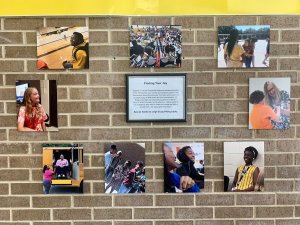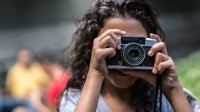A Photography Project That Develops Interpersonal Skills
Photography can help students work on communication, empathy, and teamwork—and see their communities through a new lens.
Our middle school’s mission is to shape and support a diverse community where students create high-quality work, care for the well-being of themselves and others, and engage in meaningful service. Last year, I began teaching a new course on leadership and service learning in which student-led project teams work with career mentors to address needs in the community. To equip students for success, I begin by teaching a series of lessons to promote the development of basic interpersonal skills: effective communication, empathy, and teamwork.
Focusing on Empathy
For a lesson on empathy, I partnered with a local photographer—and a parent at the school—to create a photography project called “Finding Your Joy.” I believe other educators can adapt this lesson to build classroom community while helping students identify others’ feelings, which fosters positive relationships. Lessons like this teach students how to read people, and how to understand situational context and anticipate reactions.
In the first lesson, which lasted 55 minutes, the photographer covered four sections: in photograph analysis, students learned how to identify emotions and find the story behind the image; in brainstorming, they considered what joy looks like at school; in introduction to photography basics, they learned about the rule of thirds, composition, and lighting and exposure; and in the practice section, they visited art, chorus, and drama classes to take photographs.
This assignment required students to take the focus off of themselves and watch—and anticipate—the actions of their peers and teachers. We sent a letter to staff describing the project guidelines, which covered rules like getting consent from potential subjects and not taking selfies or other posed pictures.
Helping Students View the World Through a New Lens
After the first lesson, students practiced taking pictures for one week, during which the environments expanded from the school to family and community settings. Students created a folder on Google Drive and shared their work with the photographer and myself. During that week, the students and I used the last 10 minutes of each class to revisit the guidelines, answer questions, discuss challenges, and analyze entries. For peer feedback, we followed the “two stars and a wish” format: Students identified the two strongest attributes of a photograph and shared one idea for improving the picture.
In the beginning, students struggled to give their peers meaningful feedback. Comments tended to be too general—e.g., “I like it. It’s good.” I modeled ways to provide specific feedback, which generated higher-level reflection. I asked questions like, “Why did you choose to photograph this girl?,” “Do you think the student to the left detracts from your photo?,” and “How can you crop the picture to create a stronger message?” Students took multiple pictures, so they were able to select their best work for submission. Feedback even led a few students to realize that they had missed the mark and needed to try again.
A week later, the photographer returned to teach the next lesson, which focused on analyzing student work, digital editing, and learning from one’s own work. She walked the students through a think-aloud, asking more questions about their photographs. Then, working in pairs and small groups, the class practiced editing with the tools already available on their phones and Chromebooks. For the majority of the class period, the photographer walked around the classroom and provided feedback.
From Looking to Seeing
Students submitted their three favorite photographs for the project. The photographer and I met once more to select the pictures that students believed best represented joy. We received media releases from students’ families and then posted the photographs on our school’s social media pages. We printed the winning photographs on canvas and displayed them at a local resource center for caregivers and their families. Today, the pictures are hanging in the front hallway of our school.

Students’ takeaways from this project were profound. Looking is a simple physical act; seeing represents observing and understanding. Many middle school students do not easily recognize the feelings of others, but student leaders learn that everyone has a story.
Adapting for New Formats
The project was completed last fall in a traditional classroom setting. This year, I will adapt it to my virtual teaching assignment. A photographer will now mentor my students using a service like Google Meet. Photographs will still be posted on the shared drive, but now feedback and discussion will occur during online breakout groups. The pandemic may prevent students from working closely in the classroom, but the project goals remain the same.
And there was one last lesson, which may be among the most valuable of all. A photography project allows you to see through students’ lenses. It leads to meaningful conversation. Students were highly engaged in this project from the start because they were allowed to use their cell phones and Chromebooks. Ultimately, this project served as a springboard for students to focus on others. Without vision, we have no direction. Help your students go beyond looking to seeing.
